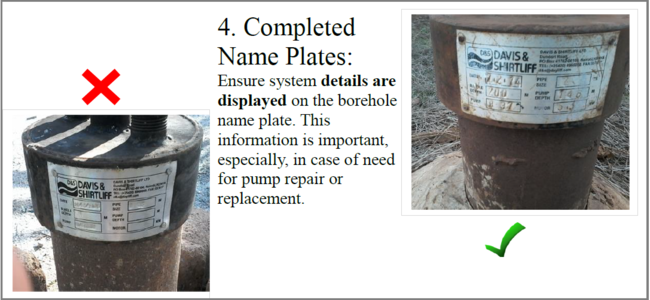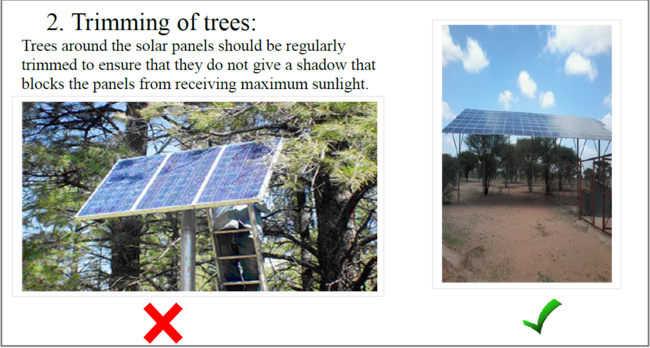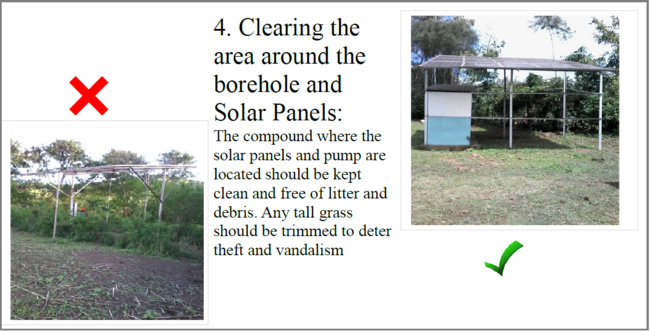Click here to register!
Difference between revisions of "Solar Pumping Toolkit - Installation and O&M"
***** (***** | *****) |
***** (***** | *****) |
||
| Line 45: | Line 45: | ||
This section of the toolkit details the steps that the scheme operator and the water point committee members should to take to ensure that the system is running efficiently. | This section of the toolkit details the steps that the scheme operator and the water point committee members should to take to ensure that the system is running efficiently. | ||
| − | + | <br/> | |
| − | + | ||
| − | + | [[File:Op & M 01.PNG|thumb|center|650px|Operation & Maintenance: Step 01]]<br/> | |
| − | + | ||
| + | [[File:Op & M 02.PNG|thumb|center|650px|Operation & Maintenance: Step 02]]<br/> | ||
| + | |||
| + | [[File:Op & M 03.PNG|thumb|center|650px|Operation & Maintenance: Step 03]]<br/> | ||
| + | |||
| + | [[File:Op & M 04.PNG|thumb|center|650px|Operation & Maintenance: Step 04]]<br/> | ||
When to call a technician<br/> | When to call a technician<br/> | ||
Revision as of 13:51, 6 November 2018
Solar Pumping Toolkit - The Global Solar & Water Initiative
Overview
Solar powered water schemes will suffer fewer breakdowns and have much less intensive maintenance than generator or hand pump schemes. However solar powered schemes can and will experience problems at some point that cannot be solved at community level (or for which the managing NGO will probably need support), regardless of the training provided.
As such it is important that if possible, service agreements are established prior to any installation, and renewed as years pass by, with a quality private contractor, water utility, water service provider of relevant government technical office. The possibility to remotely operate and monitor solar pumping schemes could also be considered in certain contexts as a way to reinforce preventive maintenance.
PHYSICAL INSTALLATION and MAINTENANCE CHECKLISTs
In order to get a good quality solar pumping installation, monitoring the field work carried out by the private contractor selected is of paramount importance. It is therefore strongly recommended to WASH officers to follow up as much as possible the below list of actions.
Introduction: 4 steps
- Check the references of all components of the system to ensure that the installed components are those provided in the design.
- Check orientation and the inclination of the panels, and shadow on the Solar PV generator. The orientation and inclination values must be close enough to those that were determined during calculations sizing. The acceptable variations will be less than 5 ° for the inclination and 15 ° with respect to the geographic North- South orientation
- Check the cleanliness and protection of the wiring, and its compliance with the standards.
- Finally inspect civil works (castle, basin, trough, fixing the solar supports ...), piping, valves and all other important elements that can compromise the sound operation of the system
O&M TOOLKIT FOR COMMUNITIES: SOLAR POWERED WATER SUPPLY SYSTEMS
Installation
This section of the toolkit outlines the things that community users should look out for during the set-up of solar-water pumping systems. Committee members and scheme operators are encouraged to work with system installers and donating agencies to ensure the five measures below are adhered to.
Operation & Maintenance
This section of the toolkit details the steps that the scheme operator and the water point committee members should to take to ensure that the system is running efficiently.
When to call a technician
- When the pump is making unusual noises.
- When there is any change in the rate of pumping- The system is pumping less water than it used to yet the solar panels are clean.
- When a bi-annual maintenance check needs to be performed.
Financial Management
This section details the prices of various solar powered water system components and demonstrates why water point leadership must ensure that they are collecting and saving water fees. Failure to collect adequate money from the community will mean that if a system component fails the committee will be unable to replace it resulting in extended periods of non-functionality (no water access).
| Prices of system components: why you MUST have water point savings [1] |
|---|
|
| Why make sure you are collecting and saving water fees? |
|---|
|
- Storing of Collected Money: Money that is collected SHOULD NOT be stored in a wallet or the treasurer’s home. It is recommended that the money should be immediately transferred to the bank. This can be easily done through mobile money banking (Mpesa, Airtel Money, Equitel).
- Accountability and withdrawing of saved money: There should always be at least two signatories when withdrawing from the bank account. Approvals must be granted by the committee and documented in meeting minutes. Three signatures One signature
Checklist and Important Numbers
This section highlights the required documents and necessary numbers that scheme operators and committee members MUST maintain.
Important Telephone Numbers
- Installation Technician________________________________
- Certified PV Installer_________________________________
- Certified Pump Expert________________________________
Important Documents
- Bank Account Registration Documents
- Equipment Warranty Certificates
- Equipment repair logs
- Pumping log / register
- Minutes of AGM meetings with the community
Important Training
- Financial Management Training
- Systems Operation Training (The scheme operator and members of the committee should be trained on how to operate the system on a day to day basis) O&M Toolkit for Communities: SPWSS | April | 2018 Page 7 of 7
References
- Contacts: Alberto Ibanez Llario & Asenath Ndegwa – The Global Solar & Water Initiative
- ↑ These are estimated values for a system with 130m total dynamic head and a yield of 8m 3/ hr. System Component costs normally depend on the size of the array as well as the type of pump used.
= Contacts =
- Alberto Ibanez Llario & Asenath Ndegwa – The Global Solar & Water Initiative





























